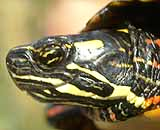|
|
|
|
Colourful Sunbathers: Petrie Island’s Turtles

Turtles at Petrie
Unique, even a bit strange, these reptiles hold a special
fascination. They have skin like lizards, beaks instead of
teeth, and their shell is actually formed by their ribs. They
are also among the oldest reptiles, going back 200 million years
to before the age of dinosaurs. They are true survivors.
Petrie island is home to the common Painted Turtle (Chrysemis
picta), as well as Snapping Turtles (Chelydra serpentina) and
Map Turtles (Graptemys geographica), both of the latter
appearing on Ontario's Species at Risk list as "of special
concern". One Musk Turtle (Sternotherus odoratus), a threatened
species, was also found at the Island in 2008.
Painted Turtles
- The painted turtle is certainly the most visible of Petrie’s
aquatic denizens. It is the most common turtle in North America
- Named for colorful markings on carapace and plastron (shell and
belly)
- Reaches adult size, about 25 cm, after 6 to 8 years Females
larger than males
- Prefers ponds, lakes and streams, often found among lily pads
and pickerel weed
- May live up to 40 years
- Spends winter under the mud at the bottom of the ponds
- From late spring to midsummer, on Petrie Island, the females
move up to sandy spots where they dig their nests and lay their
eggs. Between 5 and 12 eggs (up to 25) are laid, usually in several
nests
- Baby turtles hatch in the fall, or overwinter if it’s too cold
- When the soil reaches the right temperature, hatchlings dig
themselves out and scurry to the water
- Few hatchlings make it to adult size; gulls, crows, racoons,
dogs and other animals dig up the nests and people sometimes trample
them – never molest, pick up or handle one of the turtles
- Painted turtles eat aquatic insects, their larvae and other
invertebrates such as worms; they are fond of snails and vary their
diet with small pieces of lily pads
NOTE
- There are dozens of nests in the sand along the various trails, in
particular the Bill Holland Trail. They are chiefly nests of snapping
turtles. Please be careful when walking.
For more info,
Ontario Ministry of Natural Resources
And the Ontario conservation group Turtle SHELL –
www.turtleshelltortue.org
|
|



